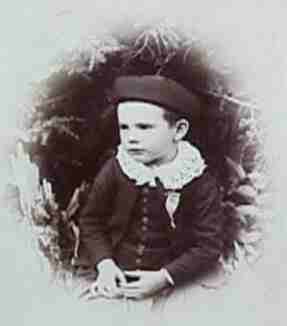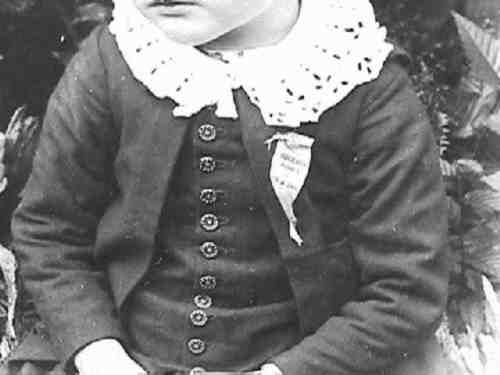
Figure 1.--This boy in a turn of the century photograph wears an attachable lace collar. Notice the cap he is wearing.


Figure 1.--This boy in a turn of the century photograph wears an attachable lace collar. Notice the cap he is wearing. |
Some lace collars were not part of a blouse, but rather sewn on to the dress, jacket, or coat. These collars were most commonly worn with Faunteroy jackets that were not styled to be worn open. The classic Fautleroy coat was very small, meant to be worn open with a fancy blouse with copious ruffles and lace trim. Some of these suits had matching wrist trim, but many did not. The attached lace collar was normally relatively small.
Some lace collars were not part of a blouse, but rather attached to a child's dress, jacket, or coat. I am not precisely sure how the collar was attached. Some may have been sewn on to the garment. Others may have simply been tied together around the boy's collar.
An attachable collar had the advantage that it could be worn with different outfits. As collars were often used to age differenbtiate boys clothes, an attachable collar could be used when a boy was younger and then left off as he got older. Thus the same jacket could be used for several years.
These collars were most commonly worn with Faunteroy jackets that were not styled to be worn open. The classic Fautleroy coat was very small, meant to be worn open with a fancy blouse with copious ruffles and lace trim. Boys might wear these with a closed jacket or a jacket and vest. Often the blouse being worn could not even be seen.
Some of these suits had matching wrist trim, but many did not. Blouses often had wrist trim which matched the large ruffled and lace trimmed collar. As the attachable lace collar was nit a one piece blose, often there was no matching wrist trim. It was somewgat more complicated to attach wrist trim then collar trim.
The attached lace collar was normally relatively small. Almost always the attachable lace colla is much smaller than the large collars that were normally part of a Fauntleroy blouse.
The attachable collars came in many different shapes. Rounded collars were very common. There were also manu shapes in geometric patterns.
The rounded style appears to have been most commonly used on girls' clothing. The boys often had collars with pointed patterns, but there was no definite convention.

Figure 2.--This enlargement shows details of the boy's lace collar, jacket, and vest. Note that the collar appears to be tied on under the boy's chin. Also notice the lack of wrist trim. |
The attachabe lace collar appears to have been a less costly alternative to an expensive Fauntleroy blouse. There were, however, many different styles and types of attchable collars. Some were costly Belgium or other importe lace. The children from less affluent families might wear a collar crocheted by their mother.
Navigate the Boys' Historical Clothing Web Site:
[Return to the Main lace collar page]
[Return to the Main lace collar type page]
[Introduction]
[Chronology]
[Clothing styles]
[Biographies]
[Bibliographies]
[Contributions]
[Countries]
[FAQs]
[Boys' Clothing Home]
